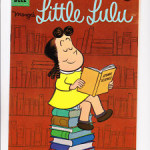I had imaginary friends when I was a little girl. (The more current term, in educational circles, is now “imaginary companions.”) I don’t remember them, but my parents told me about them, and Mother wrote their names in my baby book. Linda and Lulu. Maybe after the comics character Little Lulu? I don’t know. But I did have an actual friend named Linda, so maybe when she wasn’t around, I just conjured up an imaginary Linda to play with. Anyway, all I know about them is that once, they got left behind on a bus.
- The cartoon character Little Lulu, possibly the inspiration for my imaginary companion
- My real friend Linda, also inspiring
Because I don’t remember them at all, I can’t tell you how I felt about the bus incident. In the retelling, a few years later, my parents seemed to have been quite concerned. All I know is, if they were my imaginary friends and I left them behind on the bus, possibly I was done with them.
JoAnne, as a preschooler, never seemed to leave home without at least one (and she certainly never left one on a bus; as far as I know; but that might be because when she was three and four years old, we had a car). The best imaginary companion story in the family does involve JoAnne. She came wandering into the kitchen one morning with a stuffed animal. She was holding out its tag, which had writing on it. “What does this say,” she asked Mother. Mother looked and said, “Made in Japan.” That afternoon, JoAnne came and casually introduced Mother to the newest invisible family member, Ginjapan. Ginjapan was an entrenched part of JoAnne’s play for quite awhile, joining Good Petey and Bad Petey, and several others, whose names I’m not sure I ever knew. At any given moment, when you walked through a room where she was playing, she would be having lively conversations with dolls, stuffed animals, and/or the air around her. (She had a close friend who also had an imaginary companion, whose name was “Corduroxl,” [just guessing about the spelling.] And I don’t remember if, when JoAnne went over there to play, she took Ginjapan and one of both of the Peteys with her to keep Corduroxl company.)
Here’s the interesting thing: When I was teaching and had brought up imaginary companions in one of my Child Development classes, I asked JoAnne about her imaginary playmates. She said, “Yeah. Good Nancy and Bad Nancy.” WHO?? “Good Nancy and Bad Nancy. Good Nancy and I would play on our porch (the porch of the house where we now live), and Bad Nancy would run around the neighborhood and do all the stuff I wanted to do but would never dare to do.” Apparently, that Bad Nancy was pretty bad.
“And what about Ginjapan? And Good Petey and Bad Petey?” She doesn’t remember them. I, on the other hand, had never before heard of the Nancys.
- The front porch,
- and part of the neighborhood, where JoAnne enjoyed creatively imagining some bad deeds
Here’s what had happened: As a little girl, JoAnne (and I) played freely and openly with our imaginary companions, including them in family conversations and activities. By time JoAnne was 4 1/2 or 5, she was keeping her imaginary friends private. I don’t remember doing that. I suppose I just imagined myself doing mischievous things I would do, if I thought I wouldn’t get caught.
When I did bring up imaginary companions in the Child Development class, I was met with astonishment and, well, horror. The response was very negative. One student said, “If I ever talked about imaginary people in the house, my Mama would have taken me straight to the doctor!” So, I had to go and do research to take back to the students, to reassure them that imaginary companions are considered positive inventions, for a variety of reasons. One student finally admitted that her daughters liked to play school, and they had imaginary playmates when they did this.
For you fashioned my inmost being, you knit me together in my mother’s womb. I thank you because I am awesomely made, wonderfully; your works are wonders — I know this very well. My bones were not hidden from you when I was being made in secret, intricately woven in the depths of the earth. Your eyes could see me as an embryo, but in your book all my days were already written; my days had been shaped before any of them existed.
Psalm 139:13-16 (Complete Jewish Bible)
The very beginning of the Bible tells us that God is creative. Our own uniqueness shows how limitless his creativity is. And we are uniquely creative from the get-go. We can imagine so much. And we can use what we imagine to make and do and paint and write and fashion and build and _______(fill in the blank for yourself)____________. So, get busy.





